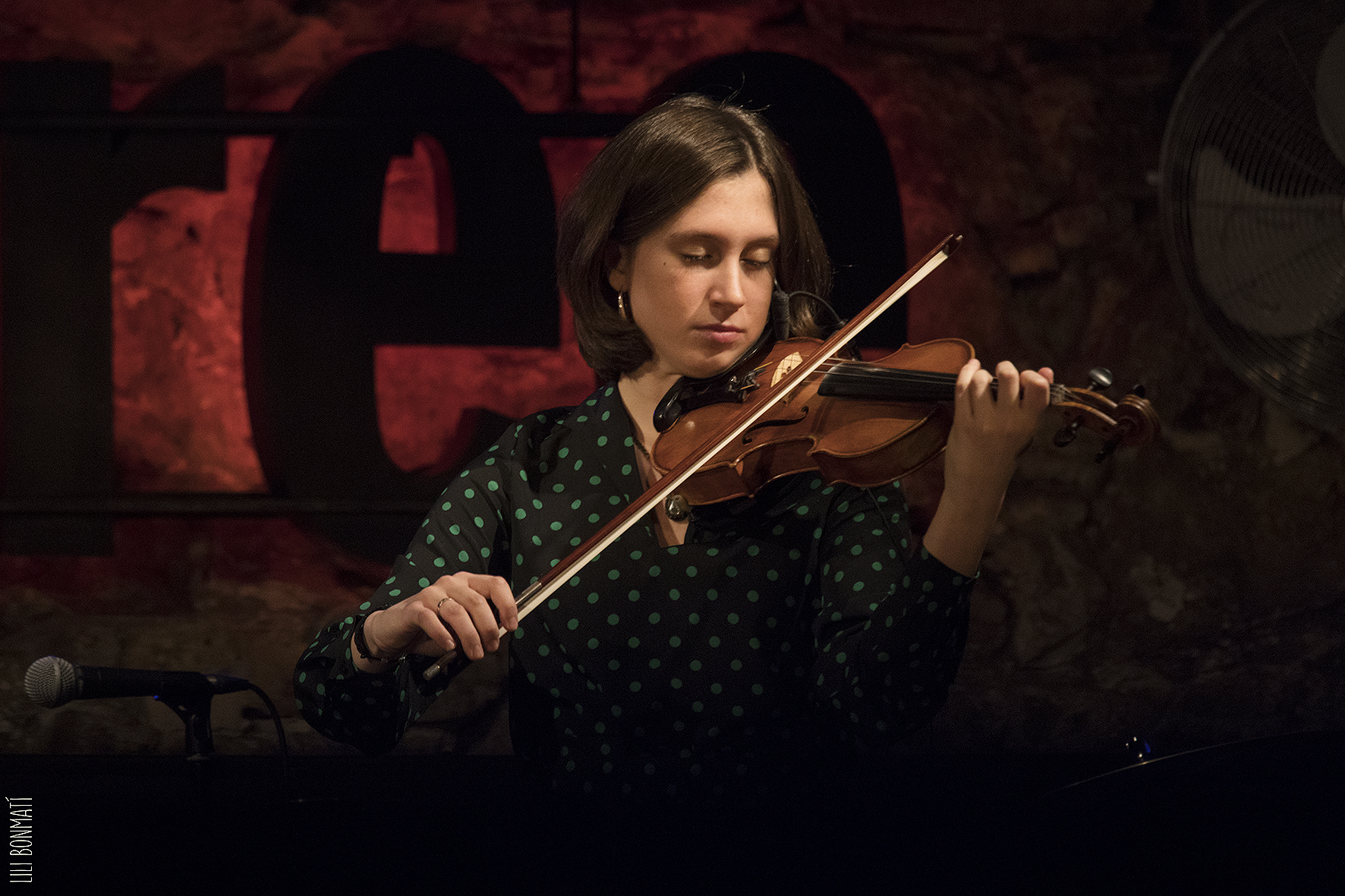
Photo: Lili Bonmati
The message on WhatsApp came three minutes earlier than expected, and I took the elevator down to let Èlia into the house where my wife and I rented an apartment during our stay in Barcelona. Èlia and I had agreed three months earlier to meet for this interview – unless she was booked for a concert outside Barcelona. Fortunately for me, no such concert was booked.
Actually we had agreed to meet at 15.30, but when Èlia after leaving another meeting realised that she would not be in time, she sent me a message and informed me that she would be ten minutes late. She was very sorry about that. Not everyone would even pay attention to being ten minutes late, and in the end it was only seven. The impression I got of Èlia in connection to an interview I conducted with her, Joan Chamorro and Carla Motis last year proved to be very right. Èlia is a reliable person. A person to be trusted. A person I would be happy to depend on, if I was a leader of a youth band and had Èlia as a senior band member.
And actually Èlia Bastida has for six years been a member of the excellent youth band Sant Andreu Jazz Band (SAJB), led by Joan Chamorro. She is now 23 years old, but as she joined the band at the age of 17 she was never a very young band member, as many of the other members have been. Although junior in the jazz context at the time she joined the band, she was not junior as a musician, having played classical music on her violin since she was four. But for the last seven years the jazz music of SAJB and different projects connected to the band have been a very important part of her musical life. And music is what dominates her daily life.
The specific reason I wanted to interview Èlia at this particular time in her life was because she is on the brink of establishing a new musical base. As Joan, Èlia and Carla unanimously declared in my interview last year, SAJB is a band that regenerates; older members at some point leave and thereby open up room for younger member to be recruited. This is where Èlia is now in life and I wanted to know how that feels and how her new music base emerges. After all, SAJB is not just any youth band. It combines the double ambition of making young people grow as musicians as well as persons in a social context – and the band is very successful in both respects. That experience is of course a wonderful asset to a young person, but to leave a wonderful experience can also be threatening. So “life after SAJB” was my concern, a common situation for all “aging” band members of SAJB.
The other thing that has changed is her opportunity to play her second instrument in the band. She is still the only violinist, so she can continue with that. But in the saxophone section there are new younger musicians, who have taken her place.
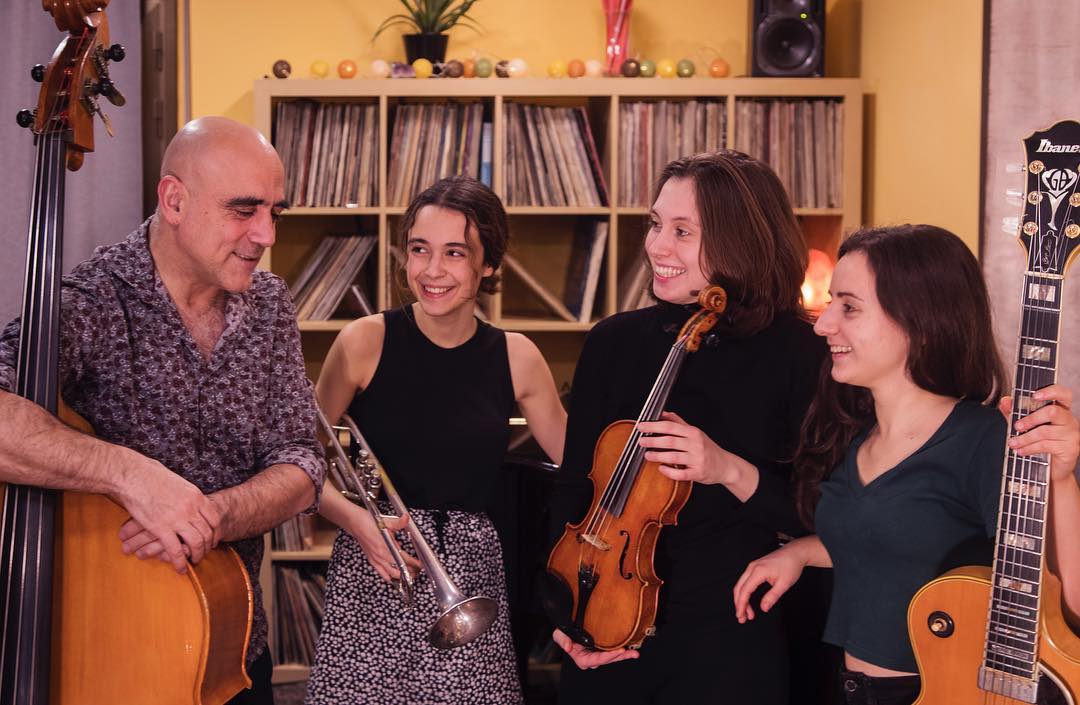
The Joan Chamorro New Quartet – a new project with Joan Chamorro, Alba Armengou, Èlia Bastida and Carla Motis. Photo by Lili Bonmati.
The dimension of SAJB that has not changed for Èlia is her opportunities to play with musicians in one way or another connected to SAJB; meaning current band members, former band members and professionals who have collaborated with SAJB. These kind of smaller band projects connected to SAJB go on all the time, Joan Chamorro being the centre of it all, and Èlia has been part of such projects most of her years as a SAJB member. So in this respect there is not really a big difference having left the big band of SAJB. In these projects she can still play her two instruments (violin and tenor saxophone), and also sing. She very much wants to continue with all of these musical forms of expression.
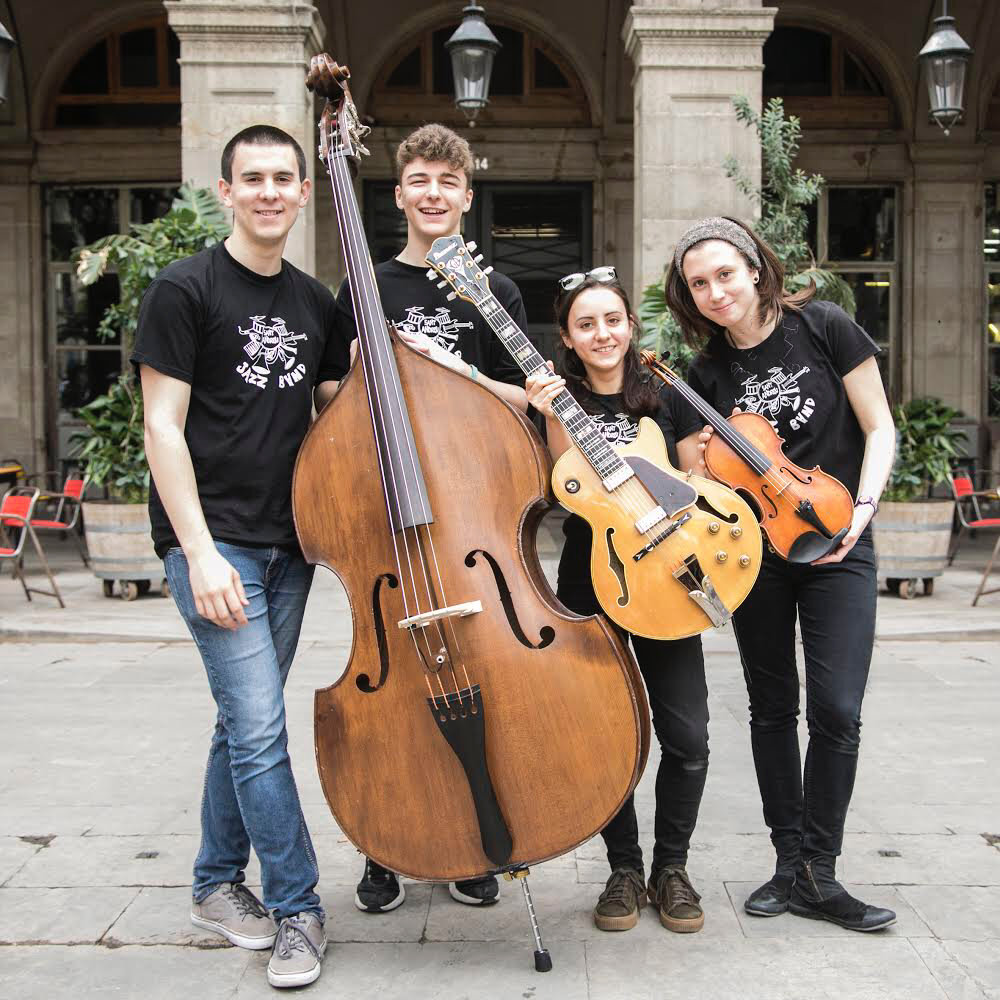
The SAJB string section. Photo by Lili Bonmati.
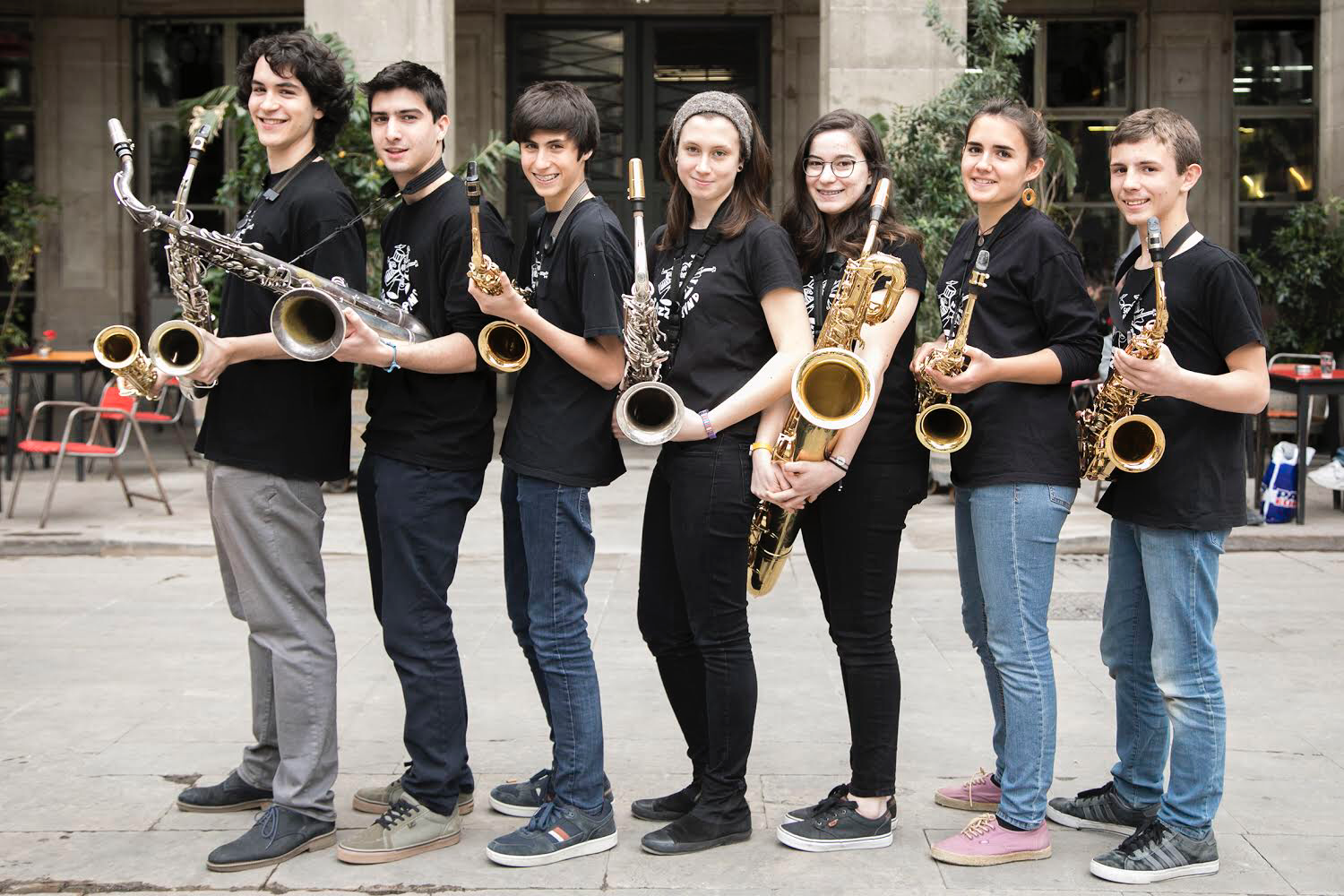
The SAJB saxophone section. Photo by Lili Bonmati.
But the narrow scope of opportunities might actually be two-sided. I believe Èlia and her fellow musicians in SAJB might not want to play in just any kind of band, playing any kind of music. They have learned to play and love some forms of jazz, and there might not be so many bands like that around these days. So even if there are bands who would welcome good musicians like Èlia and her friends in their bands, the former SAJB members might not like to play the kind of music that is requested in those bands. In the new documentary about Andrea Motis, The silent Trumpet, Andrea Motis points out that her mission in music is jazz. And Èlia tells me that starting to play jazz changed her life. Her eyes glimmer when she tells me that, and I realise that something very positive was released within her as she turned to jazz music. She appreciates the freedom of jazz and the demand to make use of that freedom. I do not think that Èlia at this point in her life can imagine playing music she does not have that kind of passion for, and a very personal relation to. So Èlia and her music friends might have to continue to create their own job market, like they so successfully have done so far. Actually, all around the world!
So, why did Èlia become a musician? Since her mother is a music teacher, playing piano herself, there was music in the family from the beginning. Èlia’s father obviously also has an interest in music, which shows in his expressive paintings of jazz musicians. When Èlia was three years old her parents wanted her to sing in the music school choir, but Èlia did not like that.
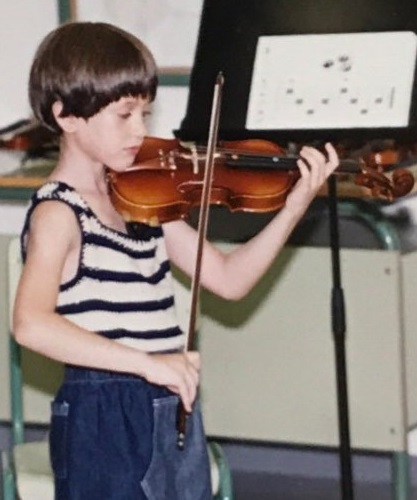
Èlia, five years old.
She wanted to play the violin! Her mother then said – if you study violin at an early age, the teacher has to be a good teacher for children. A friend of her mother who taught violin became Èlia’s teacher and she started to play when she was four. His method was built on the foundation of natural thinking. The music was classical, and if Joan Chamorro later had not appeared on the scene maybe Èlia would still be playing classic violin. Or not. Maybe turning to jazz was what was needed to release Èlia’s musical self and make her continue with music. That we will never know, but Èlia’s assurance that jazz changed her life points in that direction.
At the age of twelve Èlia started in Oriol Martorell music school, where music is integrated in the curriculum alongside other subjects. The pupils range from 6 to 18 years old, and in the school she met Andrea Motis and Joan Mar Sauqué, two of her future music friends in SAJB.
Since Èlia’s mother and Joan Chamorro both were part of music life in Barcelona they knew each other. Joan was interested in adding a violin to SAJB so he asked if Èlia would like to try to play Joe Venuti’s Pretty Trix. And yes, she wanted to give it a try. Never having played jazz before she first rehearsed this classic jazz violin piece for herself, and then asked her friend Andrea Motis to listen and judge whether Èlia’s way of playing the song was good enough. Andrea had no doubt, and Èlia then played the song for Joan, who also liked what he heard. This was in 2012. Èlia was 17 and from that day she was a member of the Sant Andreu Jazz Band. The band had by that time existed for five years. Two weeks later she rehearsed with the band for the first time and three weeks later she performed with the band at Teatre Greek in Barcelona.
The second song Joan asked Èlia to play was another jazz classic, Django Reinhardt’s and Stéphane Grappelli’s Minor Swing. Most SAJB fans have enjoyed the YouTube clip with SAJB playing that song in the outdoor concert at Plaça Reial in Barcelona, 2013.
After Oriol Martorell, Èlia started to study for a bachelor degree at Escola Superior de Música de Catalunya (ESMUC). She now attends her last year of four. The last year includes a final project, but she will do that project next year since she has so many other things to do now. Apart from a lot of concerts Èlia has lately worked on the preparation and recording of the album “The Magic Sound of the Violin”, a project she co-leads with Joan Chamorro. Carla Motis is one of the other musicians in this project. Èlia enjoys co-leading the project together with Joan, choosing songs etc. The album will be released in November 2019 at the Barcelona Jazz Festival. (At Luz de Gas.)

Èlia Bastida makes magic. Photo by Lili Bonmati.
If it had not been for Joan Chamorro and SAJB Èlia would not have started to play jazz, and she is very thankful for this turn in her life. How did that change feel?
“It totally changed my mind-set”, Èlia answers. Joan has no limits, is very open, tells you to listen, and to play a lot. In the classical world you play by the scores. In jazz you listen and play. There is no special reference for the violin. It’s the same language as for other instruments. You can sing, play saxophone, or violin – it’s the same ideas. A lot in jazz is different from classical music. They are different worlds, Èlia concludes, and she wants to live her life in the world of jazz.
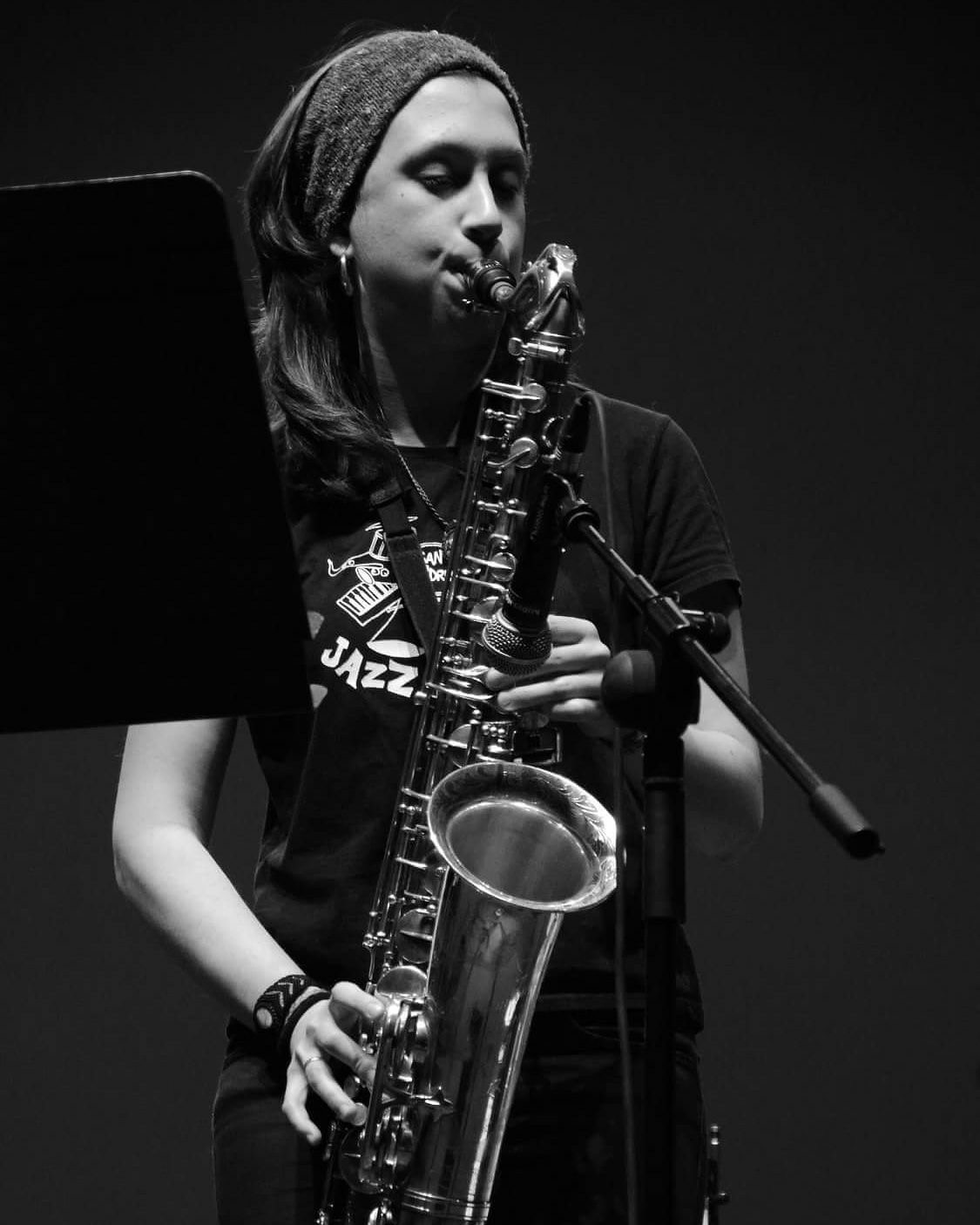
Èlia Bastida with her tenor saxophone. Photo by Angel Tejo.
So Èlia’s first instrument in the band was the violin, but she later also wanted to play the clarinet. Joan recommended that she try the saxophone instead. She did that and started with alto saxophone. After a few months there was a position free in the band as a tenor saxophonist, and if she wanted to play saxophone in the band it had to be tenor. So she started to play tenor saxophone, and now she likes that instrument better. She devotes more time to the violin, but she also loves the saxophone. And she likes to sing – Bossa Nova and other Brazilian music. Over the years with SAJB Èlia has done both lead and backing vocals. So violin, saxophone and vocals are, so far, her three musical modes of expression.

Èlia Bastida and Joan Chamorro, Photo by Lili Bonmati.
In addition, Èlia points at the opportunity to play in concerts, sometimes with big and famous jazz musicians. Often the concerts are recorded on videos of high quality, which are uploaded to YouTube. And you get the opportunity to record CDs. To get all this, the band members do not have to pay anything at all. When Èlia tells us about all this you can see that she appreciates these magnificent gifts. We know since earlier about the SAJB formula, but to hear a senior SAJB member like Èlia tell about the features of SAJB with strong emotions and gratitude gives an extra dimension to our understanding of SAJB. And probably this is only the beginning of the rich music life of a young and very talented musician.
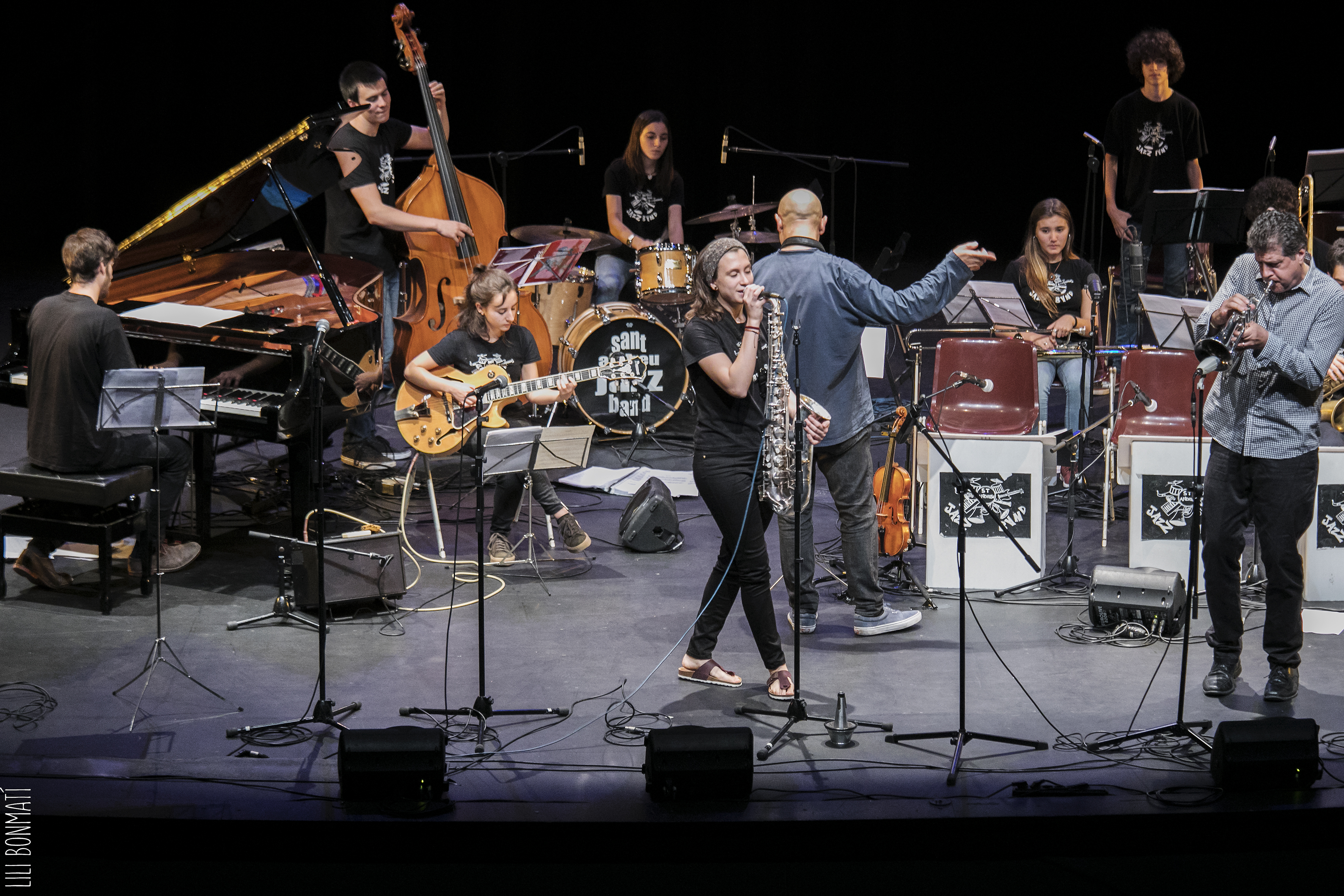
Èlia as vocalist and saxophonist with the band. Photo by Lili Bonmati.
Èlia ends our rich and long conversation with three statements:
Being part of SAJB has been a gift of great importance.
If you work for your dream; work hard with happiness and a positive mind. Then you have a better chance to reach it. This is a philosophy often expressed by Joan Chamorro that I try to bear in mind.
Music is very important, one of the most important things in life. It is my life. We don´t know the power of music in the world. Music is most important.
And I conclude for myself – it has been a pleasure to talk to this pleasant and devoted young musician, and I am looking forward to follow her career. As I will do with Joan Chamorro and Sant Andreu Jazz Band, with new young musicians to follow in the footsteps of Èlia Bastida, Andrea Motis and all the others. This part of the future is bright, and like Èlia I will try to live by the Joan Chamorro motto.
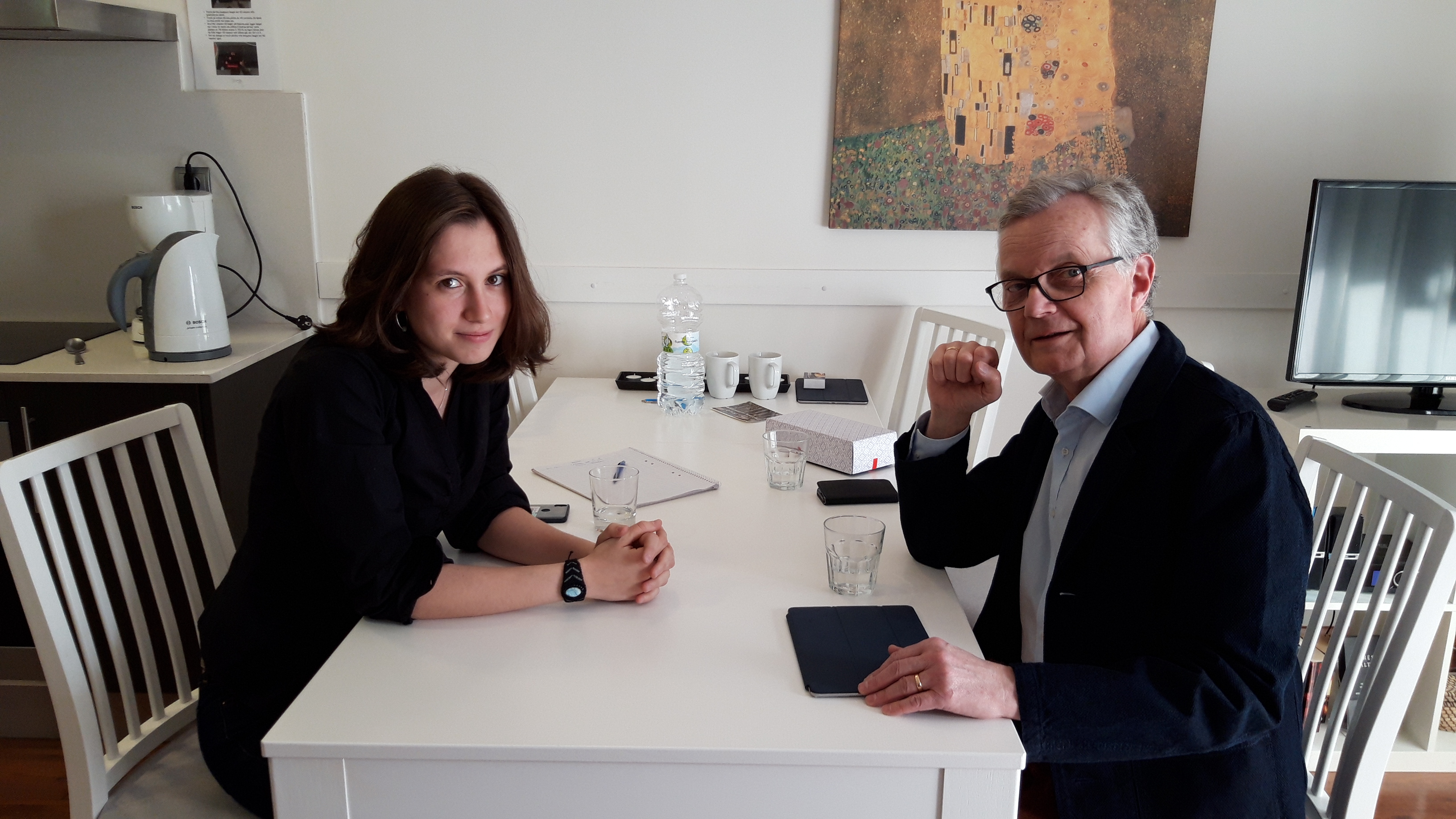
Interviewing Èlia
__________
Music videos where Èlia Bastida appears together with music friends, in one way or another connected to Sant Andreu Jazz Band
__________
The article above was published in May 2019. The new album mentioned, “The Magic Sound of the Violin”, was released in November 2019. Here are some songs from this beautiful album.
(Èlia Bastida on violin, Joan Chamorro on double bass & bass clarinet, Josep Traver on guitar, Carla Motis on guitar, Guillermo Soler on drums, David Xirgu on drums, Scott Hamilton on tenor saxophone)
__________
Related posts
Why do we love the Sant Andreu Jazz Band? (June 26, 2020)
To be sincere (May 30, 2020)
Joan Chamorro New Quartet (February 3, 2020)
Joan Chamorro (August 9, 2019)
Added reflections on The Sant Andreu Jazz Band formula (January 3, 2019)
The Sant Andreu Jazz Band formula (October 26, 2018)
La Màgia de la Veu & Jazz Ensemble (July 8, 2017)
Sant Andreu Jazz Band live (April 30, 2017)
Sant Andreu Jazz Band (September 22, 2016)